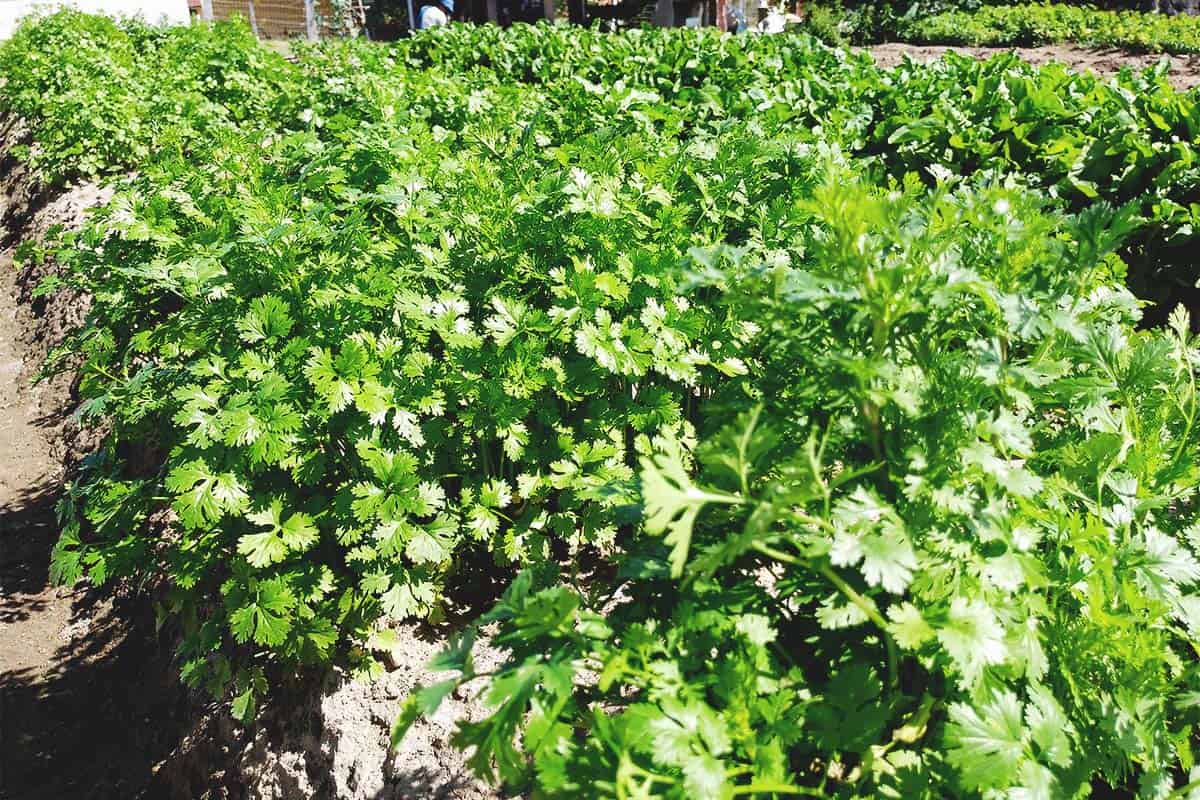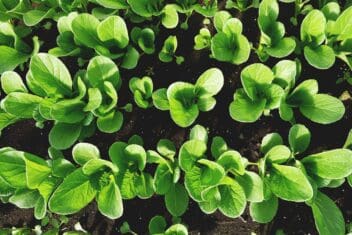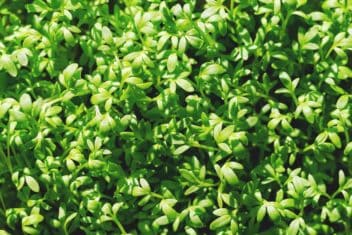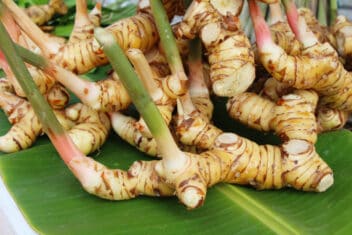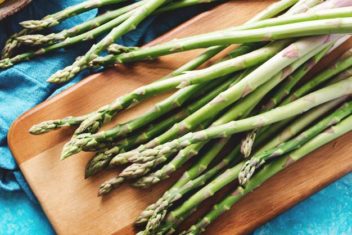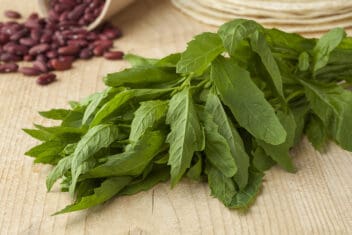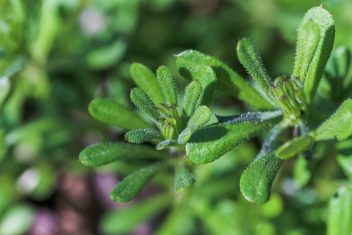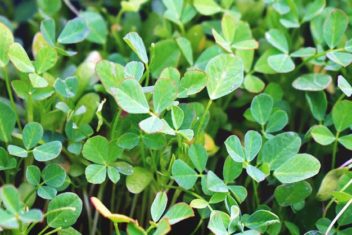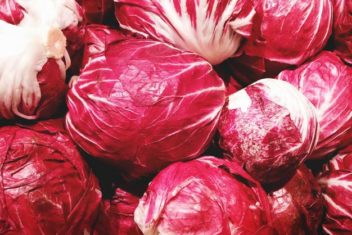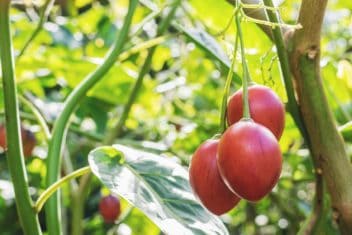I love growing cilantro because it means you get to have two herbs in one. You can harvest the tasty leaves first, and then later in the season come the citrusy seeds.
People typically have a love or hate relationship with cilantro. Some describe the leaves as having a grassy, spicy flavor, but others say it tastes like soap or even crushed bugs.
Reportedly the answer to whether you like the flavor or not lies in your genetic makeup. Odor-detecting genes relate the smell of cilantro to either fresh grass or soap. Up to 14% of people think it smells gross. Personally, I can’t imagine my favorite coconut soup without it.

Cilantro Varieties
Cilantro and coriander are the same plant. I am not sure why they ended up with two different names. In the United States, we refer to the leaves as cilantro and the seed as coriander. In Europe, the whole plant is coriander.
Calypso
Calypso is a bushy variety that produces lots of leaves. It’s slower to bolt than others. I like this variety for making fresh salsa. Harvest in 50-55 days for leaves and 120-150 days for seed. It’s an open-pollinated variety that grows to 18 inches tall.
Santo
Santo is slow to bolt and produces beautiful, edible flowers, which make a nice topping for salads and Mexican dishes. The flower also attracts pollinators.
An open-pollinated variety, the leaves have a mild flavor. It takes 50-55 days for leaf harvest and 90-105 for seed.
Cruiser
Cruiser is a hybrid that was developed for the market. The leaves are large and do well for bunching. It’s stockier and more upright than Calypso. It has excellent bolt resistance with a similar harvest schedule as Santo.
Caribe
Caribe produces an abundance of leaves and lots of pollinator-attracting flowers. It’s open-pollinated and ready to harvest in 55 days.
Planting Cilantro
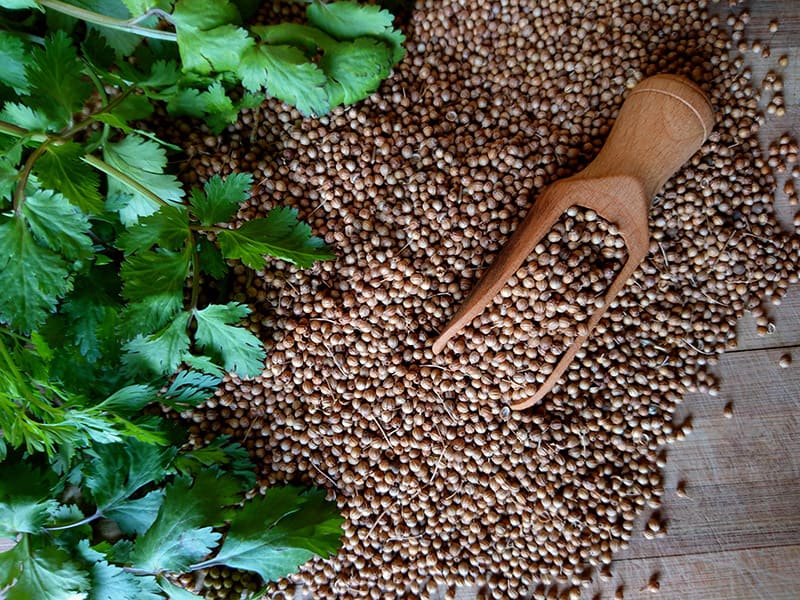
Growing Zones
You can grow cilantro in zones 2-12.
Sun Requirements
Coriander is a cool weather plant and can be put in full sun or light shade with 4-6 hours of sunlight per day. If you are growing in spring or fall then place with your lettuce in a sunny but cool location. In summer I place mine with my greens in a location that gets morning sun and afternoon shade.
Cilantro bolts quickly in hot weather. Of course, this just means you can wait and harvest the seeds to eat or save for next year’s crop.
Soil Requirements
Cilantro appreciates well-draining, loamy soil, with lots of compost and a pH of 5.5-7.0. If your soil is heavy or clay, consider placing it in a raised bed or pot.
Starting Indoors
Since cilantro likes cool weather, it’s often easier to start seeds indoors if you live in an area that gets hot early and transplant after danger of frost. Start four weeks before your last frost date. Seeds take approximately seven to ten days to sprout at 65-70°F.
Direct Sowing
You can also direct sow starting about a week before your last frost date.
Cilantro doesn’t have a long lifespan in the leaf stage, so try successive sowings every two to three weeks. Seeds germinate in about 7-10 days.
Plant them 1/4 inch deep and cover lightly with soil.
Spacing
Fun fact. The “seed” is actually a fruit. It contains two or more seeds, much like a beet. This means that thinning is necessary. Thin so seedlings are eight inches apart if you want both leaf and seed development.
When transplanting, space them 6-8 inches apart in rows spaced about one foot wide.
Caring for Cilantro
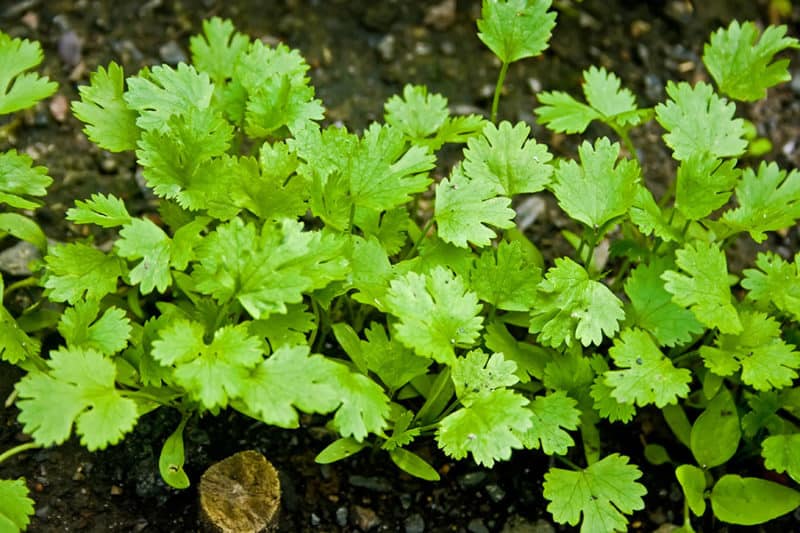
While cilantro likes cool weather it doesn’t tolerate frost. Cover plants if the weather unexpectantly dips below freezing.
Watering
Growing cilantro needs to be kept moist as it grows quickly. Make sure it gets an inch of water per week when it’s young. Once established, reduce the water slightly.
Fertilizing
Cilantro needs to be fertilized twice per growing season. Use a good organic fertilizer such as fish emulsion. Fertilizer should be high in nitrogen – use 1/4 cup for every 25 feet of rows.
Mulching
Mulch helps keep the soil cool and moist. Straw or grass clippings work well.
Problems and Solutions for Growing Cilantro
Aphids
Cilantro is often used to repel bugs so it rarely has serious insect problems. That said, if aphids are a problem spray with soapy water or use Safer soap spray.
Cutworms
The other insect to watch out for is the dreaded cutworm. Cutworms nibble plants at the base, killing them. Check out our guide for identifying and controlling them.
Root Knot Nematodes
If your plants seem stunted and wilt during the day, only to perk up at night, you may have root knot nematodes.
You can’t kill nematodes with nematicides, so buy resistant varieties, be careful not to spread soil via tillers and shovels because it will spread the nematodes, and rotate crops with brassicas.
Carrot Motley Dwarf
Carrot motley dwarf is a combination of viruses that attack cilantro, carrot, dill, and parsley. It causes stunted growth and causes leaves to change color.
It’s spread by aphids, so keep them away. Rotate crops and keep weeds away.
Leaf Spot
Sometimes cilantro has issues with leaf spot. Leaf spot appears on the plant as tiny yellow spots which turn into larger dark yellow or brown spots. An overabundance of moisture and poor air circulation contribute to leaf spot.
Prevention is providing well-drained soil, not overwatering, and thinning plants so they have good air circulation around them.
Powdery Mildew
Powdery mildew shows up as a powder-like white coating that covers the foliage during hot, dry weather. You can prevent powdery mildew by avoiding overcrowding, watering at the base of plants, and watering in the morning so plants can dry off during the day.
Companion Planting
Cilantro makes a great companion plant because it discourages pest insects such as potato beetles and spider mites thanks to its strong scent. It also attracts beneficial insects like honey and bumblebees, tachinid flies, hoverflies, and parasitoid wasps.
Try growing cilantro with:
Do not plant it with fennel, dill, carrots, or parsley.
Harvesting and Storing Cilantro
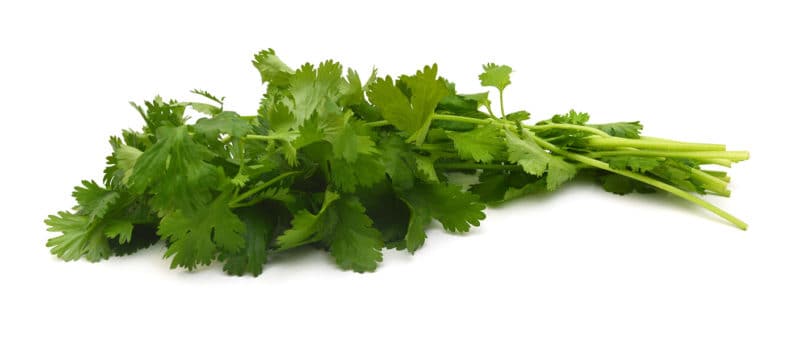
Cilantro can be cut as soon as the plant is making enough leaves and is about six inches tall. Some people harvest the leaves like cut-and-come lettuce. Others wait till the plants are taller.
Store Leaves
Using the leaves fresh is the best plan, but what do you do if you have a lot ready all at once? You can store cilantro leaves wrapped in cotton in the fridge for about a week. If you need to store longer, you can either freeze or dry them.
To freeze the fresh leaves, place them in a resealable freezer bag, press out the extra air and place them in your freezer.
Dry them by hanging or in a dehydrator. Hang a bunch someplace with good air circulation until fully dried.
Store Seeds
To store your coriander seeds, remove the seed heads when the plant begins to turn brown and starts to dry out. Put the seeds in a brown paper bag.
Cut a few holes in the bag with scissors to allow air circulation. Hang the bag for several weeks until the plant dries and the seeds separate. You can shake the bag to make sure all the seeds have fallen off.
Store the seeds in sealed glass containers in a cool, dark location.
Nutrition
Cilantro is good for you. It is a good source of antioxidants including linoleic acid, an omega-6 essential fatty acid. The leaves vitamins A, K, and C, as well as calcium
Coriander seed oil contains linalool, which is a powerful cellular antioxidant.
Medicine
Cilantro is also used medicinally. There’s some evidence that it has properties that protect you from cancer. One study showed that cilantro reduced the activity of prostate cancer.
It is also used as a sleep and digestion aid and may promote healthy skin.
Cooking
Coriander is native to North Africa and the Middle East. Both the leaves and seeds are popular in Mexican, Indian and Thai foods.
The leaf is tasty in salsas and salads. Seeds are popular ground and placed in soups and curries. The whole seed is amazing when added to sausages and pickles.
While some people hate the taste of cilantro, the seeds taste different and are more often well-liked.
Fresh Salsa
My family loves fresh summer salsa. Our basic recipe is pretty simple and one my boys learned how to do when they were young.
- 2-3 fresh picked tomatoes
- A handful of cilantro leaves
- 1/2 cup or so of sweet onion
- 1 sweet bell or several banana peppers (you could add a jalapeno pepper if you like hot salsa)
- 1 garlic clove
Plus, salt, lime juice, and pepper to taste.
Chop it all up and place in a bowl. Then grab the chips. In our home that means movie night. This also goes well in burritos or the topping for enchiladas.
Sausage Vegetable Stew with Cilantro
Another one of my favorite recipes. In summer, I make with fresh veggies. In winter I make this recipe with canned vegetables. I modified the recipe from a Mennonite cookbook by Doris Longacre.
Ingredients
- 1 package sweet Italian sausage links sliced up
- 3 cloves garlic, minced
- 2 cups chopped up cilantro leaves
- 3 cups water
- 2 large salad tomatoes chopped up
- 1 cup of rice
- 1 cup sliced carrots
- 2 small zucchini, cubed
- 2 cups potato cut in cubes
- 1 teaspoon each salt, thyme, and pepper
Method
- In a quart pan brown the sausage on medium heat stirring frequently. Drain off the grease.
- Add water, onions, and garlic to sausage and bring to simmer.
- Put in the rice and let it simmer twenty minutes.
- Add fresh veggies and continue to simmer – you may need to add more water.
- Cook till veggies are the desired texture.
- Reduce heat to low.
- Add cilantro and cook five more minutes.
- Season to taste.
The Bottom Line on Growing Cilantro
I always have cilantro growing around my house – whether it’s in the garden or on a windowsill in the winter.
Cilantro has many redeeming qualities besides its usefulness in cooking. It grows quickly and resists bugs and diseases. Once you’ve had your fill of the leaves, you can harvest the seeds and even plant a few for a new crop. It’s ideal!
